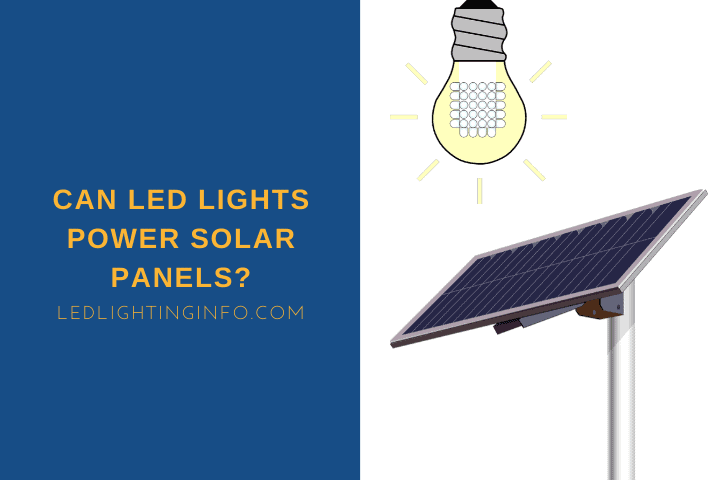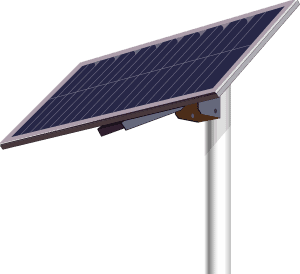Over the last 10 years, climate change has sprung to the forefront of political agendas across the globe – what causes it, and how can we minimize its impact?
As people begin to realize that the earth’s resources are finite, the demand for green technology increases.
Amongst these eco-friendly innovations, solar panels have proven to be particularly popular.
But what about those living in cloudier, duller climates, can they make use of the world’s most abundant resource?
Yes, solar technology can be powered using LED lights, albeit not as efficiently as sunlight. This is because LEDs emit similar spectrums of light as natural sunlight. However, the lumen output, color temperature, and distance of an LED bulb will each have a bearing on how much power a solar panel can produce.
As solar panels become more accessible, they’re being implemented into a wider array of devices.
But there are still concerns about how efficient solar panels are when there’s no sunlight.
Let’s take a look at how solar panels work, what conditions affect them, and whether LEDs can charge them up.
Do Solar Panels Need Sun or Just Light?
Before I jump into LEDs, it’s worth explaining how solar panels work.
The International Energy Agency notes that solar panels are the fastest-growing alternative energy source in the world.
Solar power systems make use of a physical phenomenon called the photovoltaic effect, which is the idea that sunlight can generate electricity.
The photovoltaic (PV) effect was first established in 1839 by French scientist, Edmund Becquerel.
Modern solar panels are made from semiconductors called silicon. Much like LED lights, they’re called semiconductors because each cell has two layers; one with a positive charge and one with a negative charge.
Within each layer are a bunch of densely packed atoms.
As sunlight hits the solar cell, these atoms are disturbed. Photons from the light knock electrons off the atoms, which in turn generates electricity.
The electricity is then either used to power devices or stored in a reserve bank.
This process works because the solar panel cells roughly match the sun’s spectrum, which allows the light to be absorbed.
Essentially this means that artificial lights can also be used to power solar panels provided that the spectrum of light they emit is similar to sunlight.
Because it’s easier to see than describe, here is a short video:
Does a Color Temperature of Light Affect Solar Panels?

The sun emits energy in the form of electromagnetic waves, namely ultraviolet, visible light, or infrared.
Most of the ultraviolet and infrared waves are used or lost on the journey from the sun to the earth. So the highest irradiance is obtained from the visible light region.
This region includes all colors of the rainbow and ranges in wavelength from 400 to 780 nanometres.
Based on this, manufacturers optimize their solar panels, so they primarily absorb visible light wavelengths.
This means that shorter ultraviolet waves and longer infrared waves are wasted.
Shorter wavelengths will pass right through the solar cell, but longer wavelengths will not have enough energy to knock electrons off the atoms.
Ultimately, this means that the color of artificial light has a significant impact on how much power a solar panel can produce. But what does this mean for LEDs?
Like the sun, LEDs give off visible light, infrared and ultraviolet waves.
The proportion of each depends on the color temperature of the bulb. Colour temperature refers to the shade of white light that is emitted, it is measured in degrees Kelvin (K).
LEDs are available in a variety of color temperatures. As a reference point, the color temperature of sunlight is around 5900K. So LEDs close to this color temperature will be the most efficient.
Bulbs with lower color temperatures (1000 – 5000K) will give off warmer hues that contain more infrared waves.
But bulbs with higher color temperatures (5000 – 10,000K) will give off cooler hues containing more ultraviolet wavelengths.
Since solar panels are not designed to absorb infrared or ultraviolet waves, extremely cool or extremely warm LED bulbs will not generate a lot of power.
Therefore, when choosing an LED bulb to power solar panels, aim for a color temperature between 5000 and 6000K.
Can LED Light Charge Solar Watch?

What does this mean for solar-powered technology? The panels in solar watches are usually only a couple of centimeters long, so surely, an LED bulb can quickly provide them with enough charge?
Unfortunately, it’s not that simple.
An LED bulb is no replacement for the sun. On a typical summer day, the sun produces around 1000 watts of solar energy per square meter. LED bulbs, whereas, typically have a wattage between 5 – 15W, and emit between 300 – 500 lumens.
This means it will take a lot longer to power a solar watch using an LED light than it would using sunlight. In some cases, a 15-minute charge in the sun is equal to around 8 – 10 hours of LED exposure.
Furthermore, cloudy days make solar panels charge 5 times slower. That being the case, even on a cloudy day, a solar watch will charge quicker outside than it will under an LED light.
So the short answer is yes you can charge a solar-powered watch with an LED bulb, but whether it is efficient to do so is a different question.
Also read: Do LED Lights Need A Special Photocell?
Is LED Lighting Good Alternative For Charging Solar Panels Indoor?
If your solar-powered device has run out of charge and it’s the middle of the night what can you do?
In this situation, charging the solar panel with an LED light is a good solution. Compared to traditional bulbs, LEDs are a directional source of light.
This means the LED can be pointed directly at the solar panel to maximize its impact.
CFL bulbs, whereas, are not directional, which means their light is less intense as it spills out in all directions.
When charging solar panels, this is a disadvantage as less light will reach the panel, which equates to less charge.
Despite this, LEDs should only be used to charge solar panels when there is no other option. This is because it’s counter-intuitive.
Solar panels are designed to reduce our footprint on the planet by using renewable energy from the sun.
While light from the sun is free, light from an LED is not. The electricity used to power an LED comes from the national grid, which creates electricity by burning fossil fuels.
This is exacerbated by the fact that LEDs take longer to produce the same amount of power as the sun, so the LED will need a lot of electricity.
If you’re planning a solar panel system that relies on the use of LEDs, you might want to think again!
Final Words
To summarise, LED lights can power solar panels, and they will do so more effectively than traditional types of bulbs.
But charging solar panels with electric LED lights is extremely counter-intuitive, so it should only be used when sunlight is not available i.e., at night-time.
In any case, I expect that this won’t be a problem for much longer as solar technology is rapidly advancing.
In recent years Chinese scientists have even developed innovative graphene-coated solar panels that produce electricity from raindrops!
Have you ever tried charging a solar-powered device with an LED light? How long did it take?
Let me know in the comments section below.
Looking for an LED bulb but not sure what type you need?
Check out my free bulb picker and select the right bulb within few clicks.



Comments are closed.